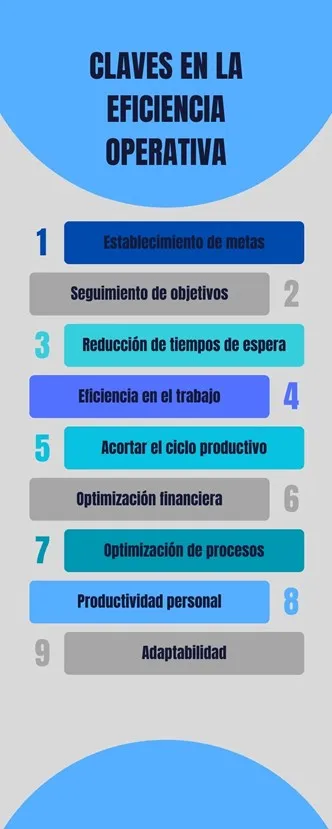In the business field it is common to focus on results, seeking to emulate the achievements of other organizations, such as leadership in the sector, waste minimization, increased turnover and cost reduction. However, this limited concentration on the result contrasts with the efforts and the path necessary to achieve them, elements that are revealed as keys to operational efficiency . In this article, we will delve into this aspect.
As humanity has evolved, its perspectives have also changed and management methodologies have been developed with the purpose of optimizing work efficiency through the identification, design, implementation and optimization of processes. Operational efficiency is based on activities aimed at generating quality products and services at the lowest cost.
Merging skills: In search of operational efficiency
In organizations, to achieve the desired fluidity, reduction of waiting times, productivity, adaptability to changes, meet delivery deadlines and maintain performance and quality, it is of utmost importance for managers and collaborators to have technical and social to carry out the activities.
Currently, the importance of soft skills is highlighted as personal attributes that contribute to the improvement of interaction and work methods, especially notable as personnel competencies. Among them, organization and time management emerge, which are fundamental personal skills that, applied strategically by teams of collaborators in the work environment, become pillars that guarantee operational efficiency.
Time management
Time management is a process that involves favorable practices and development of skills to improve the use of valuable and scarce resources such as time. It includes planning, organizing and prioritizing activities, with the purpose of achieving specific goals efficiently and effectively, contributing to personal and organizational productivity, as well as the optimization of processes.
Stephen Covey (1996), addressing the habits of highly effective people, highlights the importance of managing time in a structured manner and carrying out tasks according to their priority levels. Time management is about taking conscious control of how we invest each available moment, recognizing the importance, the time necessary and the effort required for each task. This strategic approach seeks to avoid delay, reduce unnecessary workload and reduce waiting times.
In the work environment, time management involves the application of various tools and techniques, such as the subdivision of work, organization in task lists, establishment of priorities, use of calendars and schedules, implementation of concentrated work intervals and rest times.
In addition, it is supported by concepts such as the identification of time thieves and the application of strategies to maintain concentration and personal awareness, seeking to contribute to greater personal productivity and achieve efficiency at work.
A critical component of time management is the ability to set clear, measurable goals. Aligning daily activities with long-term objectives creates a framework for decision-making and fosters a sense of purpose. Time management is not just about doing more things in less time, but about doing the right things at the right time.
It should be noted that time management is a changing and evolving approach, a continuous process of improvement, with regular reflection, identification of areas for improvement and adaptation to changing circumstances.
Likewise, it is helpful to internalize time as a limited and valuable resource. To improve its management, it is necessary to know where it is invested and wasted, group tasks by affinity, consider the use of slack in activities and identify those with precise time.
Ultimately, it not only seeks to increase personal productivity, but also to influence the quality of life by minimizing the stress associated with tight deadlines, allowing a healthy balance between work and rest, becoming a valuable tool to maximize individual potential and achieve success as teams in a sustainable way.
Relationship between time management and organization
Time management and organization are intrinsically related, as both skills work hand in hand to improve work efficiency and productivity. Some factors incident to time loss and disorganization include lack of or misinformation, lack of delegation and division of work, communication problems, inadequate planning, postponing decision making, unrealistic deadlines for activities, tardiness, among others. others.
In this sense, the Lean manufacturing methodology is a set of production management principles and tools that seeks continuous improvement through the reduction of waste, maintenance of order, among other notable aspects and has been widely applied in the industrial sector. proving effective in improving these skills. To learn more about this related topic, you can consult the article ” Lean Manufacturing within the framework of an ISO 9001:2015 Quality Management System ” .
Keys to operational efficiency
The achievement of operational efficiency does not occur in isolation, it constitutes a set of key factors that contribute to the expected success. Among these are:
Goal setting
Goal setting is the starting point for effective time management. By defining clear and achievable goals, companies provide their staff with a framework for their daily activities. Well-established goals serve as a guide, allowing time management to be directed toward achieving specific results.
Goal Tracking
As a control mechanism, it is a continuous practice that drives improvement. Through the periodic review of objectives and individual and collective performance, expressed in indicators, companies identify areas of opportunity and adjust their approach to process optimization.
Reduction of waiting times
By minimizing downtime, companies can improve efficiency with process optimization and deliver faster, more satisfying results to their customers. This is achieved through process analysis, careful planning and assignment of tasks, identifying and eliminating bottlenecks that can slow down operations, having agile processes and the ability to respond to demands. Effective time management is not just about doing things faster, but doing them more intelligently and strategically.
Work efficiency
It involves the allocation and optimal use of resources through estimates and cost management, organizing tasks, establishing priorities, avoiding errors and rework, and improving the quality of products and services. They are determining practices to improve work efficiency, as well as the formation of teams and their leadership, measurement of their performance and implementation of corrective actions in case of deviations.
Shorten the production cycle
From an economic perspective, reducing the cycle time for generating goods and services, the period it takes to bill and obtain income, represents a gain because with this reduction in waiting times for sales, we are obtaining the possibility of obtaining higher sales per unit of time. This is where time management and organization are decisive.
Financial optimization
Cost control as an organizational tool in the management of economic resources contributes to maximizing results by reducing waste and improving profitability. Time is money in business terms. Funds must be used strategically, without compromising quality. When carrying out audits, the organization is subjected to a thorough evaluation of its processes, practices and systems to guarantee compliance with standards, identify areas for improvement and ensure the effectiveness of its operations.

Financial implications of operational efficiency. Video courtesy of the College of Public Accountants of Mexico .
Optimization of processes
Identifying redundancies, eliminating unnecessary steps, reducing waste and implementing continuous improvements are practices that guarantee fluidity in operational processes. Adaptability to market demands and new approaches, coupled with change management through the use of new technologies, contribute significantly to adjustments and improvements for the development of processes.
Personal productivity
It is the sum of individual efficiencies within a team. Time management on a personal level, combined with efficient task organization, directly contributes to the overall productivity of a team. Setting clear, measurable goals, followed by diligent objective tracking, ensures that each team member is aligned with the company’s overall objectives.
Adaptability
In the opinion of Vásquez (2010, cited in Frías and Véliz, 2013) adaptability is the agility with which the organization responds to its external clients and its willingness to change. It is a measure of the flexibility of the organization. The degree of adaptability refers to the ability to effectively assimilate the changes faced. Time management and organization allow companies to be agile and respond to changing market conditions.

Conclusion
Finally, time management and organization are key to operational efficiency in asset management. What we call keys to operational efficiency are goals achievable through effective time management. By setting clear goals, diligently tracking objectives, and maintaining adaptability, companies can not only improve their current results, but also prepare for future challenges and opportunities. Investing in these skills is essential to building a strong, sustainable foundation for long-term business success .
References
- Covey, S. (1996): The 7 Habits of Highly Effective People. Mexico City: Editorial Paidos Mexicana.
- Frías, J. and Véliz, J. (2013). Adaptability to unforeseen changes in the environment and the creation of capabilities for self-control in the company. Administrative Technique, 12(53), 1-12. Recovered from http://www.cyta.com.ar/ta1201/v12n1a2.htm

